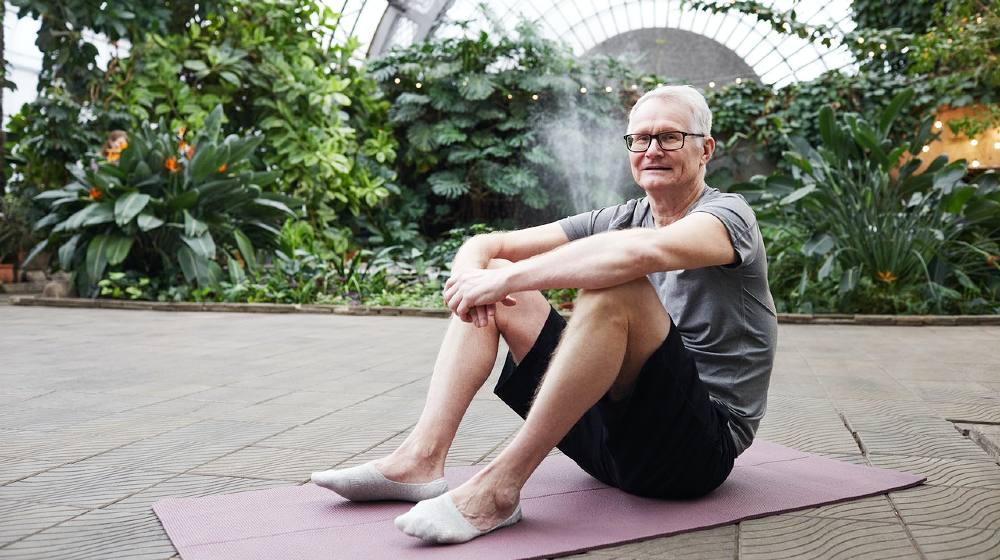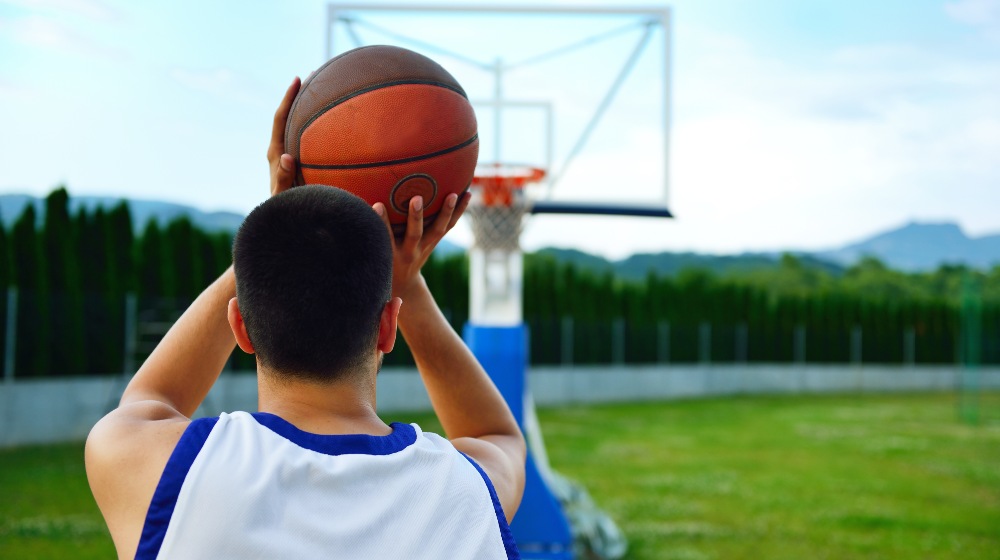12 Conditioning Exercises for Bad Knees
Struggling with bad knees? Working them out may actually be more beneficial than resting them. And the best part – you can do them at home.
Related: 5 Easy Core Exercises for Seniors
Quick and Easy Conditioning Exercises for Bad Knees
Easy Stretching Exercises for Bad Knees
1. Hamstring Stretch

You'll feel the stretch on the front muscles on your thighs and the back of your knees.
If you keep your feet flexed throughout the routine, you'll be able to feel stretch from your hamstrings all the way down to your calves.
Here's how to do it:
- Lay down on your back.
- Bend your knees and flex your feet.
- Lift one leg and straighten it.
- Grab onto the back of your thighs with both hands and pull it close to your body. If it's difficult to reach your thighs with your hands, you can use a towel or resistance band around your thighs.
- Maintain the position for 30 to 60 seconds.
- Repeat steps 1-5 with your other leg.
Do two to three reps, four to five days a week.
2. Thigh Stretch

In this exercise, you'll feel the stretch at the front of your thighs.
The muscles at the front of your thighs, called quadriceps, play a role in the movement of your hips and knees. This workout could improve your flexibility, increase your range of motion, and keep your knee joints from stiffening.
Here's how to do it:
- Stand up straight with your feet firmly planted on the floor. You may lean on a wall or grab hold of a chair to help you balance and support yourself.
- Bend your knee, pulling your heel toward your buttock.
- Grab your ankle using your hand on the same side and use it to bring your heel even closer to your body.
- Maintain the position for 30 to 60 seconds.
- Repeat steps one to four on your other leg.
Do two to three reps, four to five days a week.
3. Calf and Heel Stretch

This exercise will work out your calves and ankles.
The gastrocnemius muscles run from the back of your knee down to the heel bone. Meanwhile the soleus muscle lies beneath the gastrocnemius muscle and ends at the heel bone. Together, they are called the triceps surae or gastrocnemius/soleus complex.
The gastroc muscle is in charge of flexing the knee. Both the gastroc and soleus muscles bend the ankle. Together, they help you walk or run.
Here's how to do it:
- Face a wall, placing your palms flat upon them. Maintain a straight posture.
- Keep your toes pointed toward the wall.
- Bring your injured or bad knee straight behind you. Your better knee should be slightly bent at the front.
- Push your hips forward toward the direction of the wall.
- Maintain the position for 30 seconds.
- Rest for 30 seconds before returning to step 1.
Do two sets of four, six to seven times a week.
Strengthening Exercises for Bad Knees
4. Half Squats

You'll be engaging your thighs and buttocks in this low-resistance squat workout.
If you're just starting out, avoid using weights in your hands until you feel strong enough. Then you can begin with five-pound weights, followed by 10-pound weights later on.
Here's how to do it:
- Stand upright with your feet positioned shoulder width apart.
- Keep your toes pointed forward.
- You may lean on a wall or on the backrest of a chair for support. But be careful to maintain proper posture, not letting your shoulders go past your knees.
- Keep your spine and upper body straight as you dip into a squat.
- Bend down by as much as 10 inches for half squats.
- Maintain the position for five seconds.
- Press your body weight on your heels as you stand back up.
Do three sets of 10, four to five days a week.
5. Hamstring Curls

You'll be activating the muscles behind your thighs (hamstrings) in this exercise.
Here's how to do it:
- Place your hands against a wall or grab onto the back of a chair for support.
- Gently and slowly lift your leg with an injured knee backward, bringing the heel toward your buttocks. Lift it as high as you can raise it without any pain.
- Keep your feet flexed as you bend your injured knee.
- Keep your leg raised for five seconds then bring your foot down.
Do three sets of 10, four to five days a week.
RELATED: 7 Helpful Tips To Relieve Joint Pain
6. Calf Lifts

This time, you'll be working out your calves on the leg with an injured or bad knee. Strong calves may help stabilize your bad knees.
Here's how to do it:
- Plant your palms against a wall, or stand behind a chair and hold the backrest for support.
- Lift your healthy or uninjured leg, leaving the leg with the bad knee planted on the ground. Keep your toes pointed in front of you. By maintaining your joints at their natural position, you may prevent further injury.
- Slowly raise your heel on the leg with the bad knee as high as you can without pain. Apply your weight on the balls of your feet, then lower your heel back down.
Do two sets of 10, six to seven days a week.
7. Seated Leg Raises

Engage your quadriceps with this low resistance workout. Start out without using any ankle weights. When doing this workout without any weights begins to feel light or easy, you may start using 5-pound ankle weights. Eventually you may want to increase to 10-pound weights.
However, bear in mind that this exercise should not be painful. If leg raises with weights are painful, stop the exercise immediately.
Rely on your muscles to lift your leg and avoid swinging your leg in an effort to raise it. This may only add more stress to your knees and will not properly engage your quadriceps.
Here's how to do it:
- Sit on a chair with your back straight.
- Activate your thigh muscles on the leg with the bad knee. Slowly and gently straighten your knee and lift it as high as possible without any pain.
- Maintain this position for five seconds before lowering your leg.
Do three sets of 10, four to five days a week.
8. Leg Raises (on Your Back)

This exercise focuses on your quadriceps, the muscles that run from your hips down the front of your thighs.
Avoid engaging your upper body muscles (shoulders or core) to help raise your leg, relying only on your thigh muscles.
You may do this at the gym with assisted machines if this proves to be a bit challenging. A trainer will also make sure that you maintain proper form throughout your session.
You may add 5-pound or 10-pound ankle weights later on as you strengthen your muscles and find the exercise progressively easier to execute.
Here's how to do it:
- Lay down on the floor and proper yourself up with your elbows.
- Straighten your bad knee and keep your foot flexed. Bend your healthy knee with the bottom of your feet planted firmly on the floor.
- Activate your thigh muscles in the leg with the bad knee and raise it up by six to 10 inches off the floor.
- Keep it raised for five seconds before lowering it back down gently.
Do three sets of 10, four to five days a week.
9. Leg Raises (on Your Stomach)

This time, you'll be activating your glutes (muscle on the buttocks) and hamstrings (muscles on the back of the thighs).
If this is your first time, exercise without any weights. As you build strength, you may add 5-pound ankle weights and increase to 10-pound ankle weights later on.
Keep in mind, however, that you should not feel any pain during your workout.
Here's how to do it:
- Lay on your stomach and place your arms underneath your forehead.
- Straighten both legs.
- Engage your glutes and hamstrings on the leg with the bad knee.
- Lift it as high as you can without pain, keeping your knees extended.
- Maintain the position for five seconds before bringing your leg back down.
- Relax for two seconds before lifting your injured leg again.
Do three sets of 10, four to five days a week.
10. Side Leg Raises (Hip Abductors)

You'll feel the burn at the outer section of your thigh and on your buttocks in this low-resistance workout.
Like the other routines, start without using any ankle weights. You may begin using them when you feel that you are stronger and if you don't feel any pain. Start with 5-pound ankle weights before you increase to 10-pound ones.
Here's how to do it:
- Lie down on the side of your healthy knee. Prop yourself up on your elbow and rest your head on your hand. Your injured or bad knee should be on top, while your healthy knee should be bent underneath to support you and stabilize your movements.
- Extend your bad knee as far as you can without locking it, and lift it to a 45° angle.
- Maintain the form for five seconds before bringing your leg back down.
- Rest for two seconds then repeat.
Do three sets of 20, four to five days a week.
11. Side Leg Raises (Hip Adductors)

This exercise is similar to the previous one, except you'll be activating your hip adductor muscles.
If you're just starting out with knee conditioning exercises, opt out of using weight bearing equipment. The additional resistance may hurt your knee further. When you feel like this exercise is easier to do, add resistance by attaching a 5-pound ankle weight. Work your way up to 10-pound weights if you can execute this routine without pain.
Remember that these workouts should not be painful. If at any point you do experience any pain, stop the workout and call your doctor.
Here's how to do it:
- Lie down on your side and prop yourself up with your elbow and rest your head on your hand. Your injured or bad knee should be underneath, while your healthy knee should be above and in front of your bad one.
- Lift your leg with the bad knee approximately six to eight inches off the ground.
- Maintain the position for five seconds.
- Lower your leg for a two-second rest.
Do three sets of 20, four to five times a week.
12. Leg Presses

This routine will work out your quadriceps (muscles at the front of the thigh) and hamstrings (muscles at the back of the thigh).
You'll need resistance bands for this exercise. Choose one that doesn't give too much resistance, opting instead for something more comfortable. Over time, you may choose one with progressively more resistance.
Here's how to do it:
- Lie down on your back with your arms at your sides.
- Hold one end of the band on each hand and bend your elbows at a 90° angle, elbows still touching the ground. Place the middle of the band to the bottom of the arch of your foot on the leg with the bad knee.
- Keep your feet flexed throughout the exercise.
- Engage your thigh muscles, bend your knee, and bring it toward your core until you create a 90° angle.
- Extend your bad knee slowly and gently, pushing against the resistance band.
- Maintain this position for two seconds.
- Relax your leg on the floor.
Do three sets of 10, four to five days a week.
Strength, Flexibility, and Bad Knees
The muscle groups surrounding your knees work alongside them to help you move. Strengthening these muscles will help support your knees and lessen the stress you apply on your knee joints. Stretching and flexibility exercises could help ease soreness while increasing your range of motion.
Muscles You Need to Exercise for Bad Knees
There are five muscle groups you need to work out when you have problematic knee pain. The workouts on this list focus primarily on these muscles:
- abductors
- adductors
- hamstrings
- quadriceps
- glutes
Abductor muscles are those that help your limbs move away from your body. They're located on the outer thigh. This list includes a workout for the hip abductors, which help your thighs rotate away from your midline.
In contrast, adduction muscles help your limbs move toward the center of your body or midline. They're located at the inner thigh and are also called groin muscles.
The hamstrings are a group of three muscles that wrap around the back of your thigh, beginning at the hip down to the end of your knee. They're not involved in forward motions like walking, but are in charge of vertical movements. These include jumping, climbing, and running.
The quadriceps consist of four muscles that wrap around the hip and knee joints. It's in charge of flexing your hips and straightening and extending your knees. These help you run, jump, and kick.
Your gluteal muscles include the gluteus maximus, gluteus medius, and gluteus minimus. The gluteus maximus is the largest muscle in the buttocks. It's in charge of thigh extension and lateral rotation. While the gluteus medius rotates your thighs away from your body. Lastly, the gluteus minimus stabilizes the hips and internally rotates the thigh medially.
Other Workouts for Bad Knees
After you've built some strength, you may try out other exercises that can also be beneficial for knee pain. There are other workouts you can do at the pool or fitness club that are hard on the muscle, but low-impact and easy on the joints.
These include:
- swimming
- tai chi
- stationary cycling
- yoga
- water aerobics
- water walking
- leisurely walks
Believe it or not, exercise could be the solution to your woes.
Keeping your knees stationary out of fear of pain may actually make it more stiff. Exercising them could help increase their mobility as well as ease the pain.
These low-impact exercises may help improve their condition. Focus on improving their range of motion, flexibility, and strength.
If at any time you feel pain, stop the exercise and visit your doctor. Stick to exercises that you can do comfortably.
Arthritis or injuries could really add the “knee” to “agony.” These workouts may help prevent further injury, ease pain, and condition them to better health.
Ready to feel better? Let us know if this article helped ease your mind and knee pain in the comments section below.
You Might Also Like:
Trending
How To Do Air Squats
Winter Reflection: How to Reset and Thrive This March!
Get Updates
SIGN UP FOR OUR NEWSLETTER TODAY



